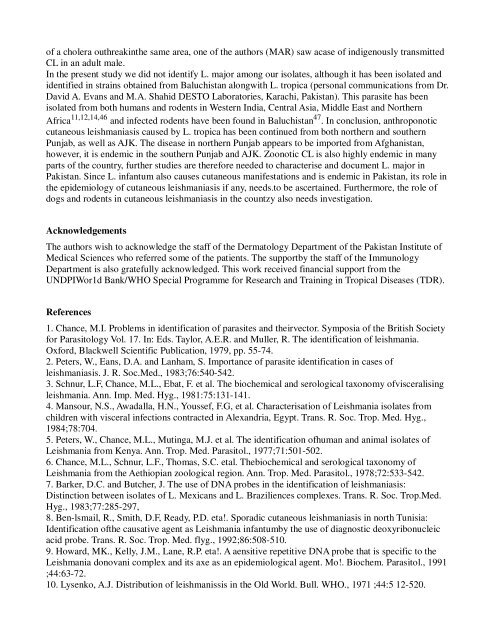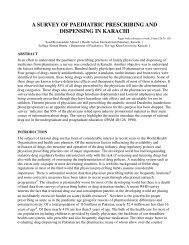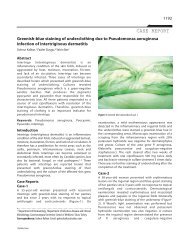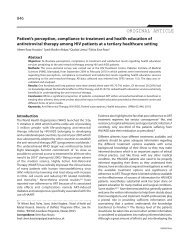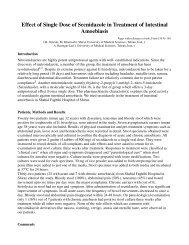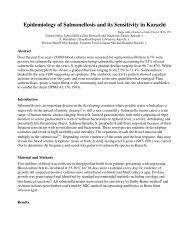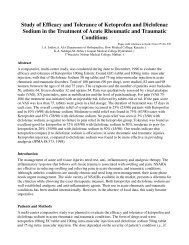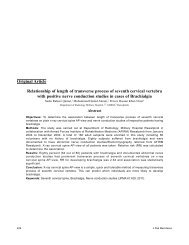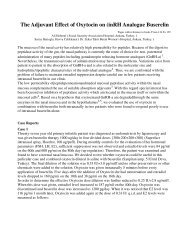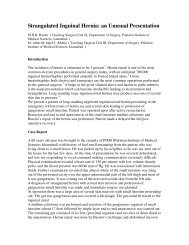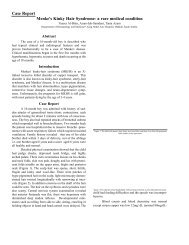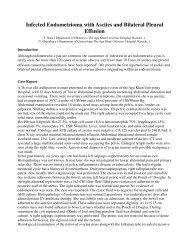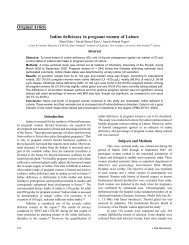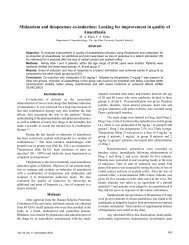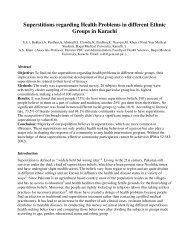Cutaneous Leishmaniasis : Iso-enzyme characterisation of ...
Cutaneous Leishmaniasis : Iso-enzyme characterisation of ...
Cutaneous Leishmaniasis : Iso-enzyme characterisation of ...
You also want an ePaper? Increase the reach of your titles
YUMPU automatically turns print PDFs into web optimized ePapers that Google loves.
<strong>of</strong> a cholera outhreakinthe same area, one <strong>of</strong> the authors (MAR) saw acase <strong>of</strong> indigenously transmitted<br />
CL in an adult male.<br />
In the present study we did not identify L. major among our isolates, although it has been isolated and<br />
identified in strains obtained from Baluchistan alongwith L. tropica (personal communications from Dr.<br />
David A. Evans and M.A. Shahid DESTO Laboratories, Karachi, Pakistan). This parasite has been<br />
isolated from both humans and rodents in Western India, Central Asia, Middle East and Northern<br />
Africa 11,12,14,46 and infected rodents have been found in Baluchistan 47 . In conclusion, anthroponotic<br />
cutaneous leishmaniasis caused by L. tropica has been continued from both northern and southern<br />
Punjab, as well as AJK. The disease in northern Punjab appears to be imported from Afghanistan,<br />
however, it is endemic in the southern Punjab and AJK. Zoonotic CL is also highly endemic in many<br />
parts <strong>of</strong> the country, further studies are therefore needed to characterise and document L. major in<br />
Pakistan. Since L. infantum also causes cutaneous manifestations and is endemic in Pakistan, its role in<br />
the epidemiology <strong>of</strong> cutaneous leishmaniasis if any, needs.to be ascertained. Furthermore, the role <strong>of</strong><br />
dogs and rodents in cutaneous leishmaniasis in the countzy also needs investigation.<br />
Acknowledgements<br />
The authors wish to acknowledge the staff <strong>of</strong> the Dermatology Department <strong>of</strong> the Pakistan Institute <strong>of</strong><br />
Medical Sciences who referred some <strong>of</strong> the patients. The supportby the staff <strong>of</strong> the Immunology<br />
Department is also gratefully acknowledged. This work received financial support from the<br />
UNDPIWor1d Bank/WHO Special Programme for Research and Training in Tropical Diseases (TDR).<br />
References<br />
1. Chance, M.I. Problems in identification <strong>of</strong> parasites and theirvector. Symposia <strong>of</strong> the British Society<br />
for Parasitology Vol. 17. In: Eds. Taylor, A.E.R. and Muller, R. The identification <strong>of</strong> leishmania.<br />
Oxford, Blackwell Scientific Publication, 1979, pp. 55-74.<br />
2. Peters, W., Eans, D.A. and Lanham, S. Importance <strong>of</strong> parasite identification in cases <strong>of</strong><br />
leishmaniasis. J. R. Soc.Med., 1983;76:540-542.<br />
3. Schnur, L.F, Chance, M.L., Ebat, F. et al. The biochemical and serological taxonomy <strong>of</strong>visceralising<br />
leishmania. Ann. Imp. Med. Hyg., 1981:75:131-141.<br />
4. Mansour, N.S., Awadalla, H.N., Youssef, F.G, et al. Characterisation <strong>of</strong> Leishmania isolates from<br />
children with visceral infections contracted in Alexandria, Egypt. Trans. R. Soc. Trop. Med. Hyg.,<br />
1984;78:704.<br />
5. Peters, W., Chance, M.L., Mutinga, M.J. et al. The identification <strong>of</strong>human and animal isolates <strong>of</strong><br />
Leishmania from Kenya. Ann. Trop. Med. Parasitol., 1977;71:501-502.<br />
6. Chance, M.L., Schnur, L.F., Thomas, S.C. etal. Thebiochemical and serological taxonomy <strong>of</strong><br />
Leishmania from the Aethiopian zoological region. Ann. Trop. Med. Parasitol., 1978;72:533-542.<br />
7. Barker, D.C. and Butcher, J. The use <strong>of</strong> DNA probes in the identification <strong>of</strong> leishmaniasis:<br />
Distinction between isolates <strong>of</strong> L. Mexicans and L. Braziliences complexes. Trans. R. Soc. Trop.Med.<br />
Hyg., 1983;77:285-297,<br />
8. Ben-lsmail, R., Smith, D.F, Ready, P.D. eta!. Sporadic cutaneous leishmaniasis in north Tunisia:<br />
Identification <strong>of</strong>the causative agent as Leishmania infantumby the use <strong>of</strong> diagnostic deoxyribonucleic<br />
acid probe. Trans. R. Soc. Trop. Med. flyg., 1992;86:508-510.<br />
9. Howard, MK., Kelly, J.M., Lane, R.P. eta!. A aensitive repetitive DNA probe that is specific to the<br />
Leishmania donovani complex and its axe as an epidemiological agent. Mo!. Biochem. Parasitol., 1991<br />
;44:63-72.<br />
10. Lysenko, A.J. Distribution <strong>of</strong> leishmanissis in the Old World. Bull. WHO., 1971 ;44:5 12-520.


